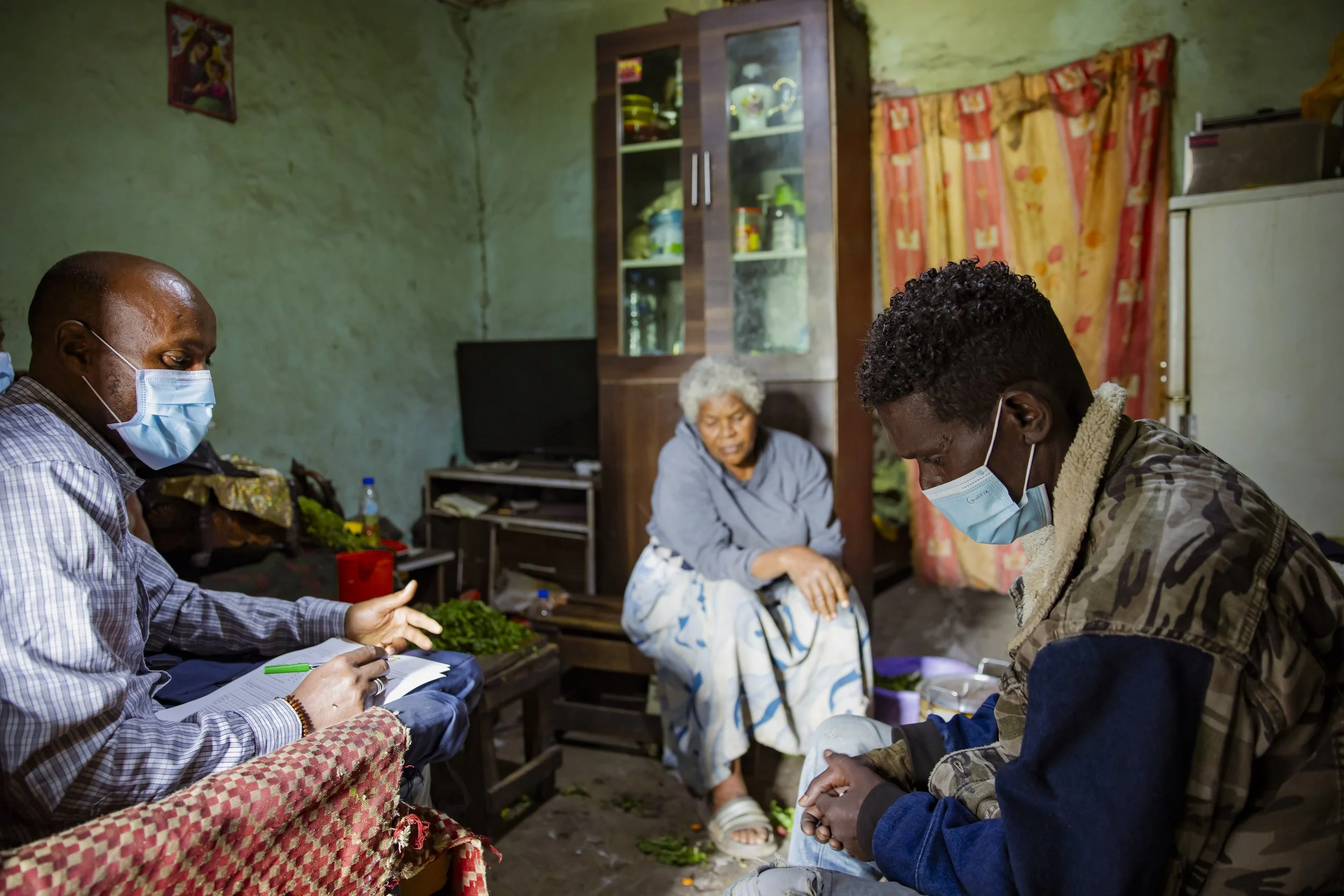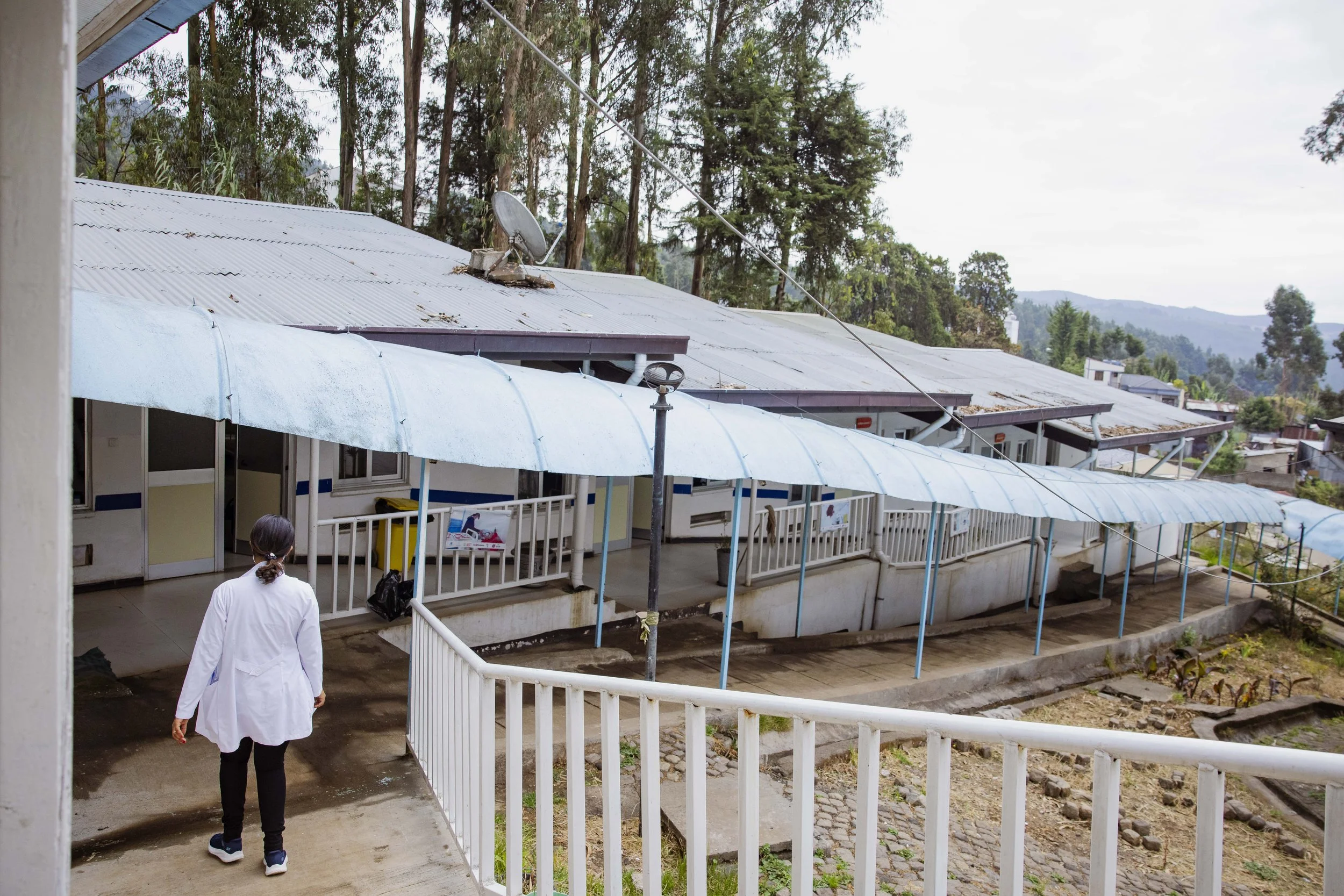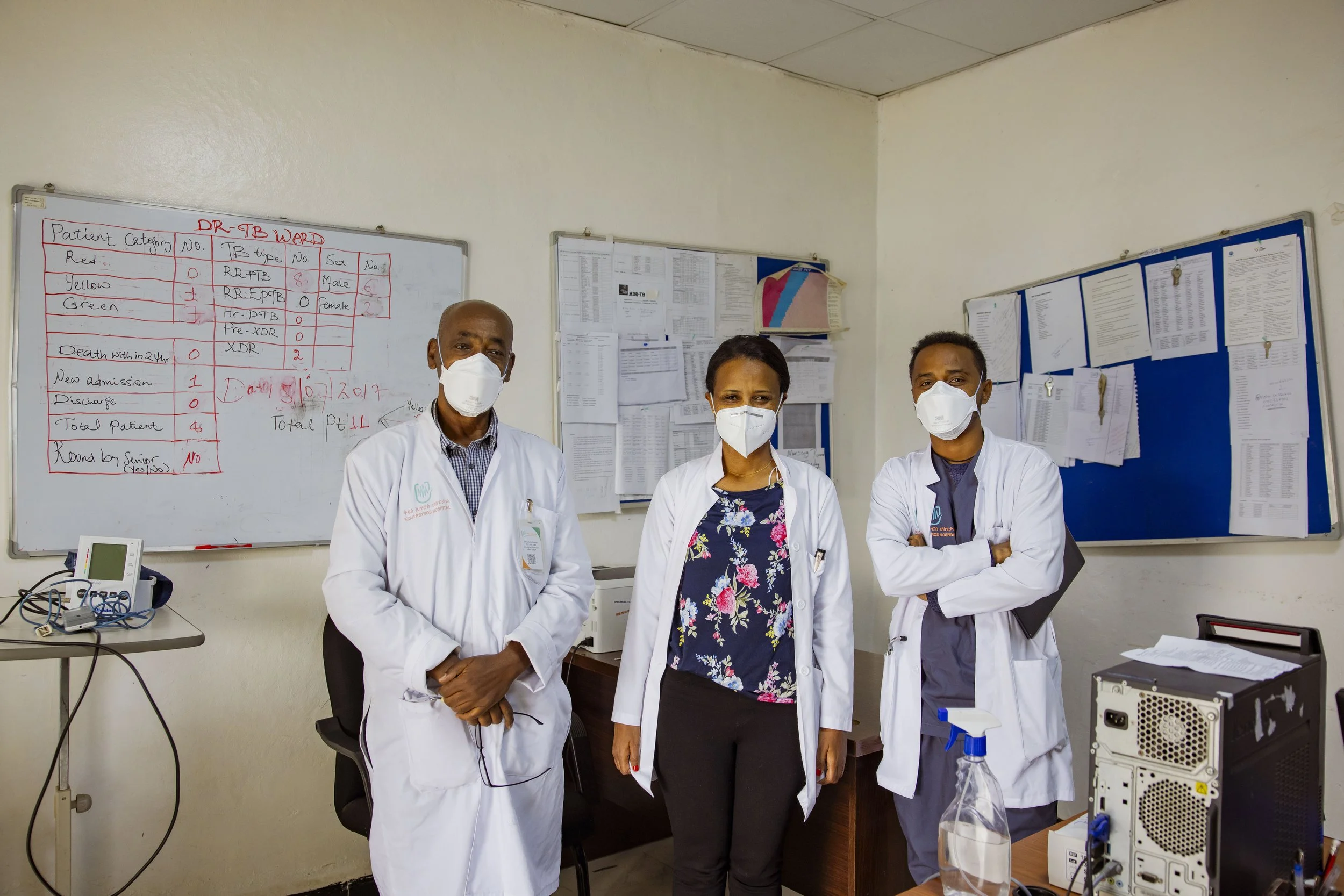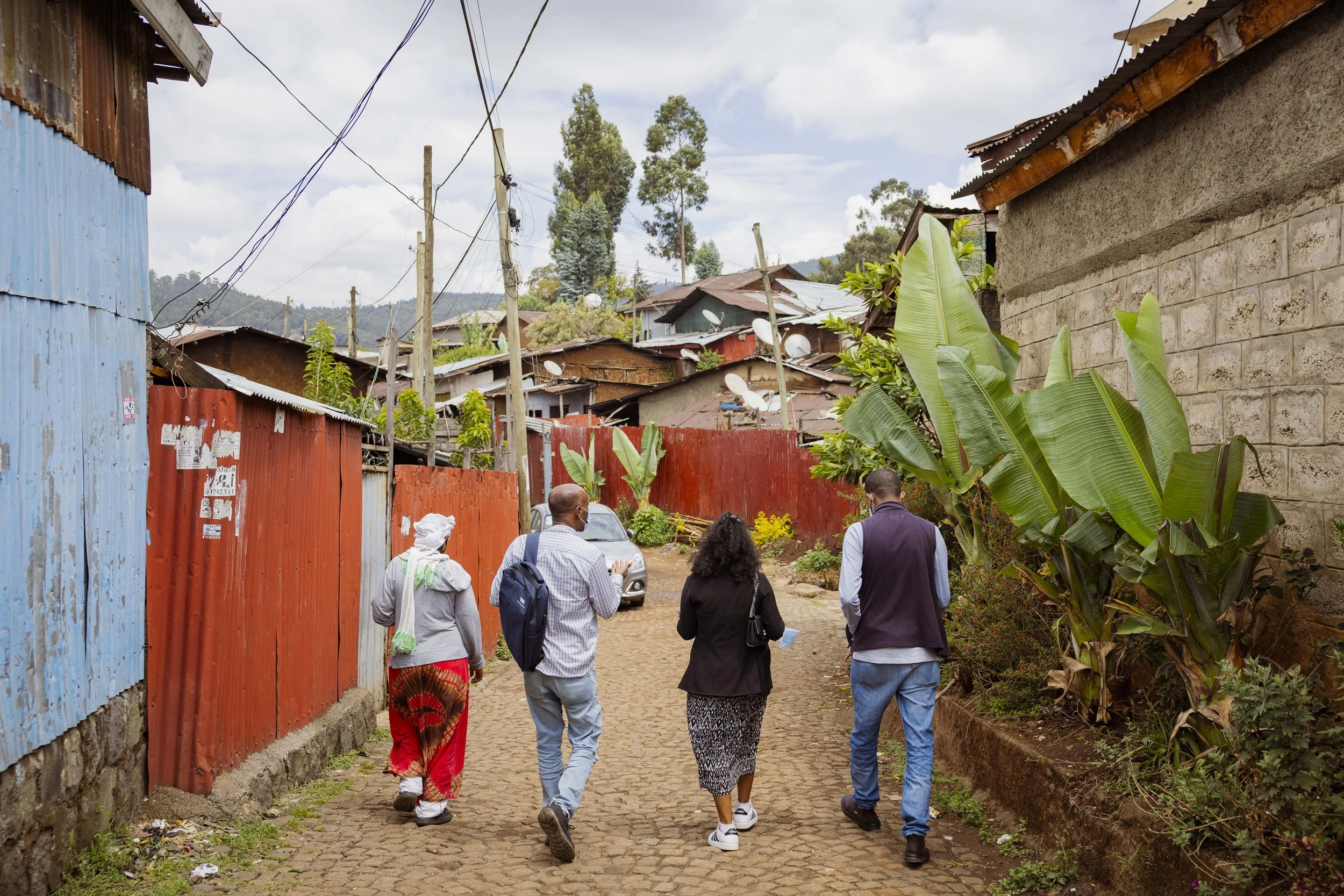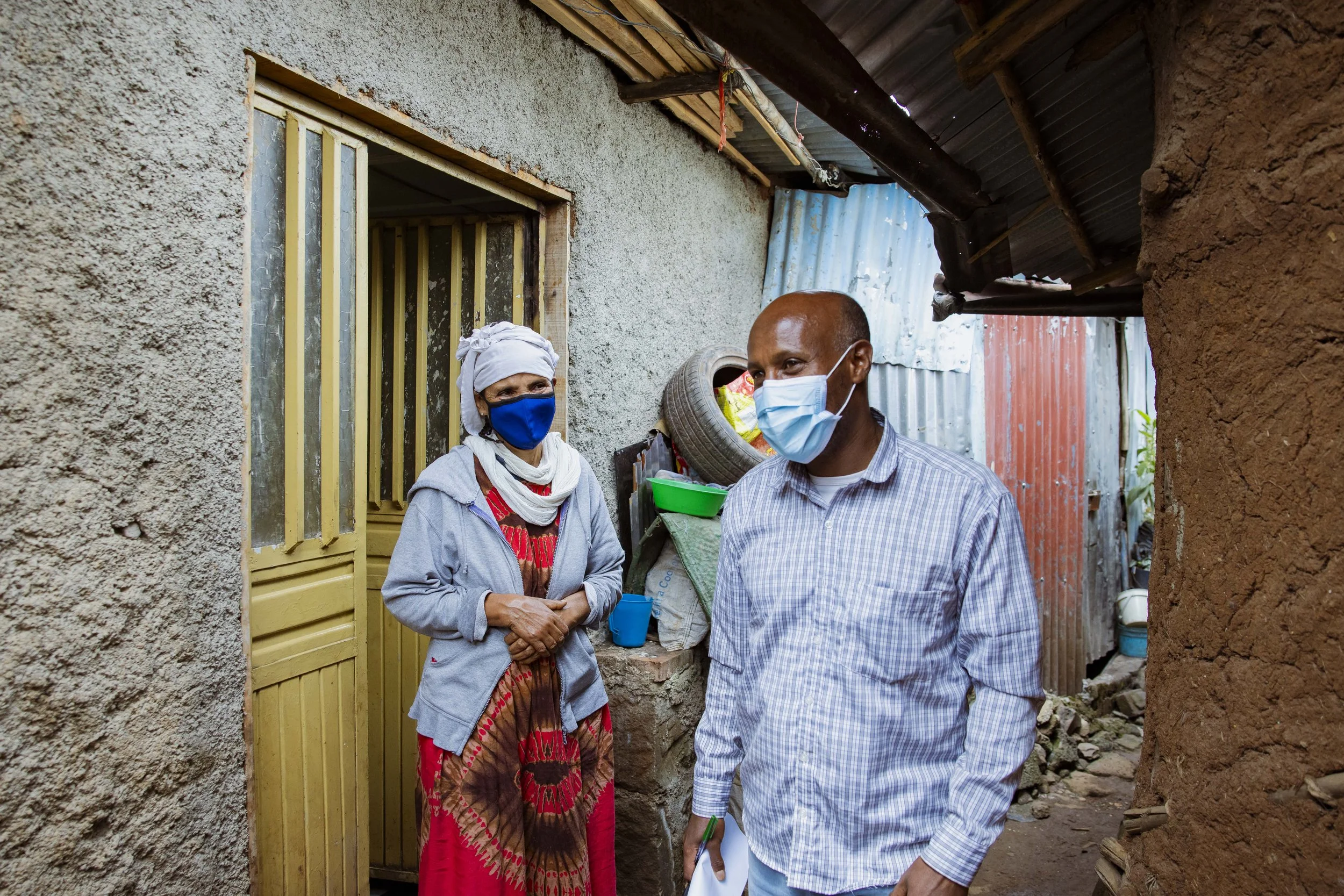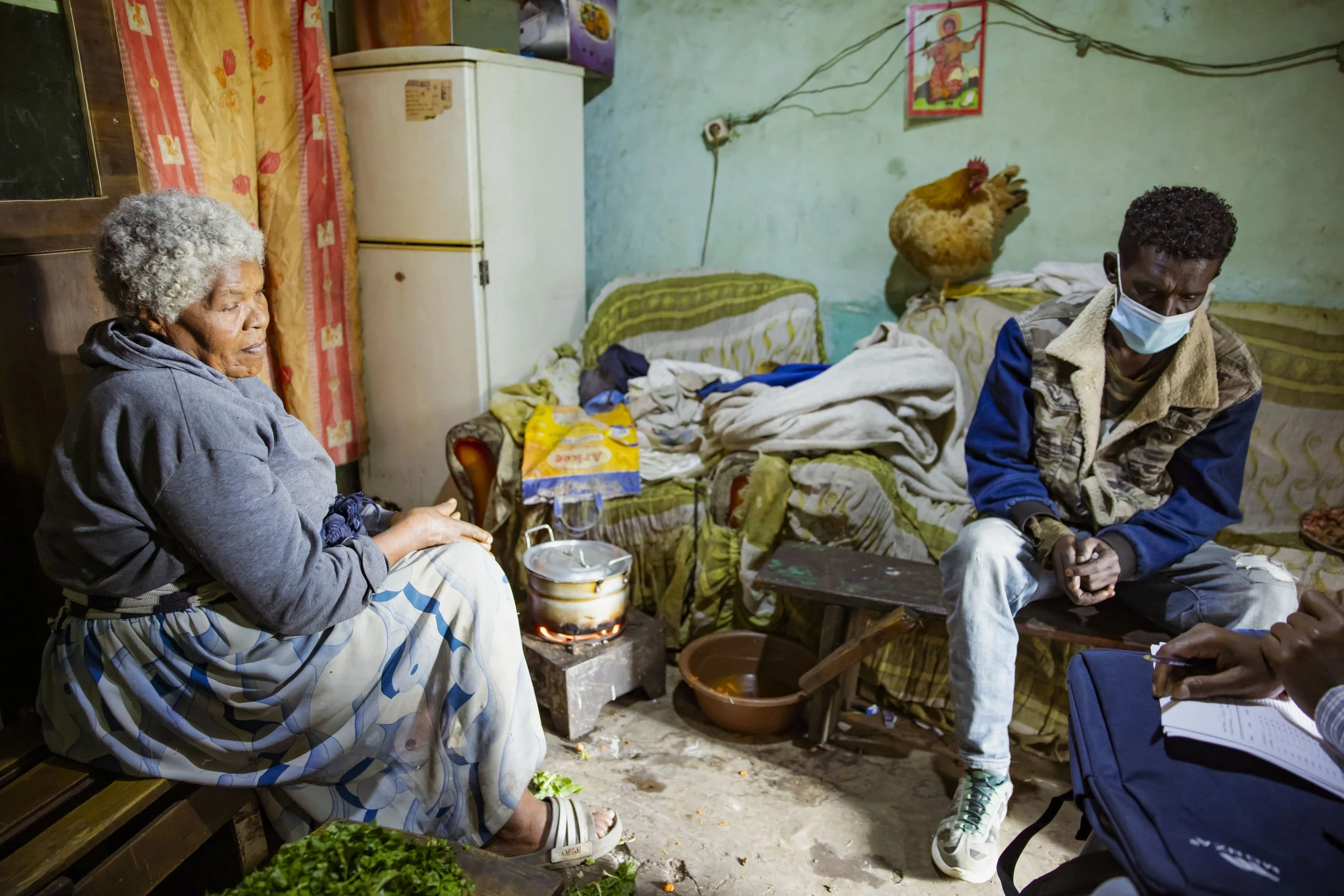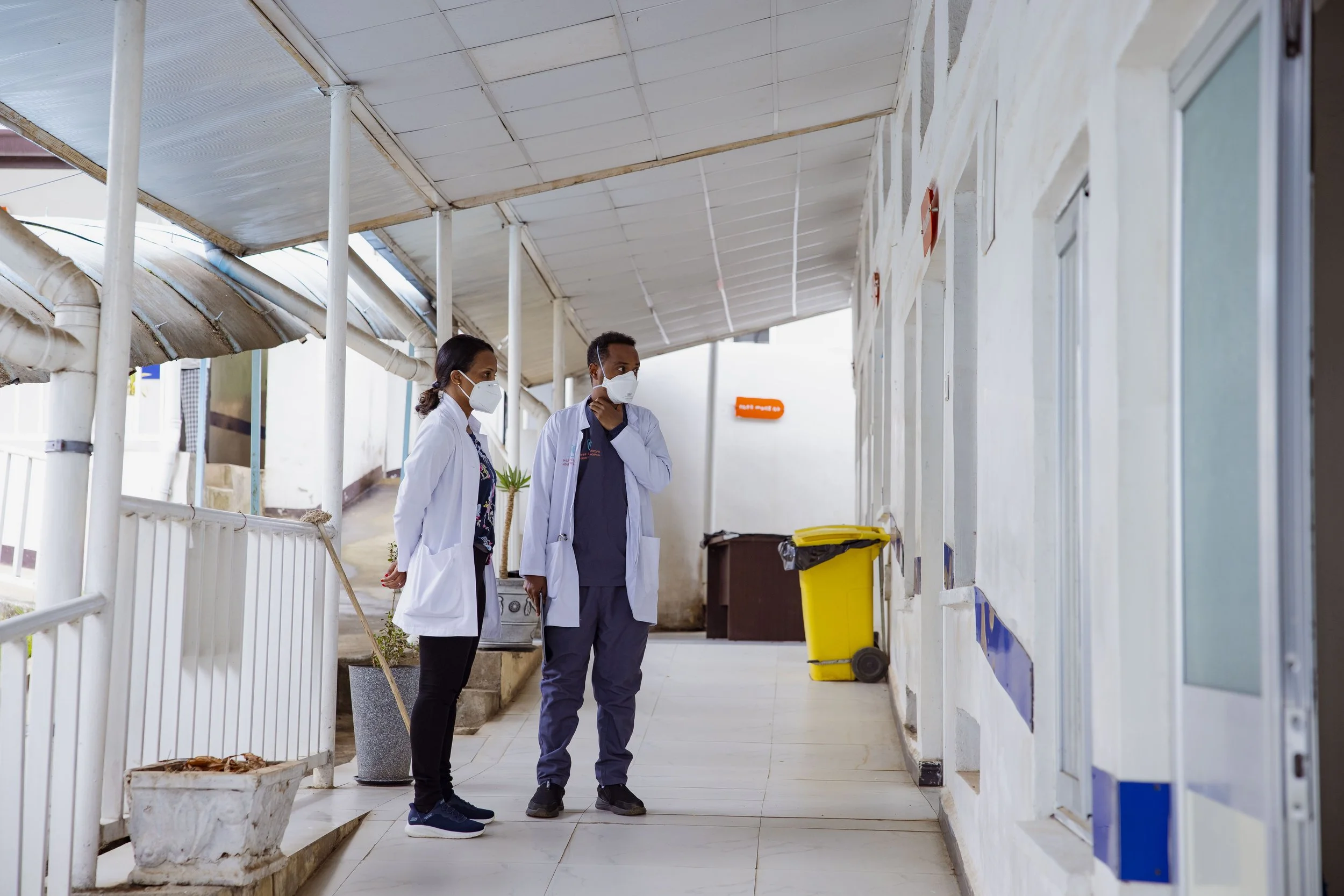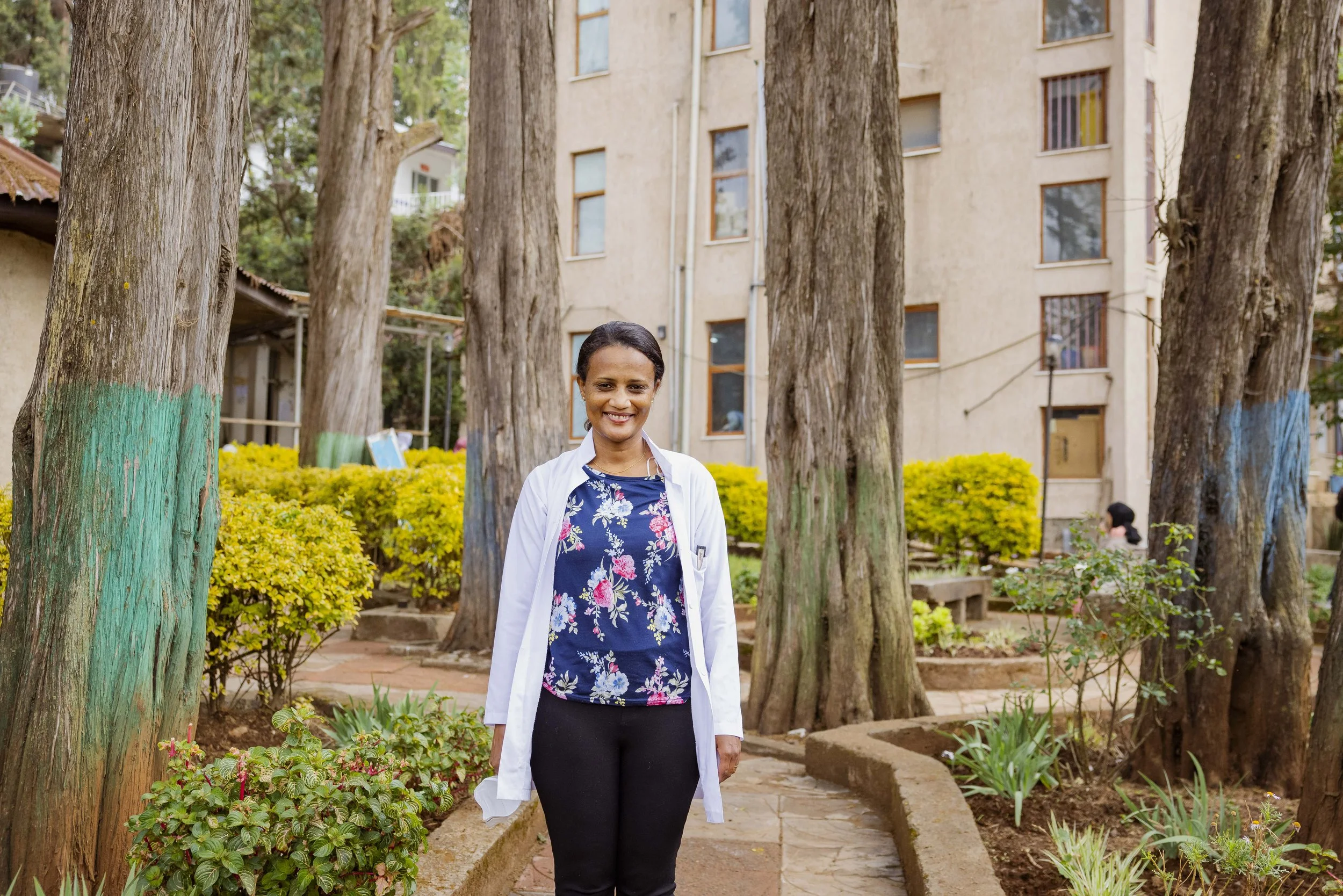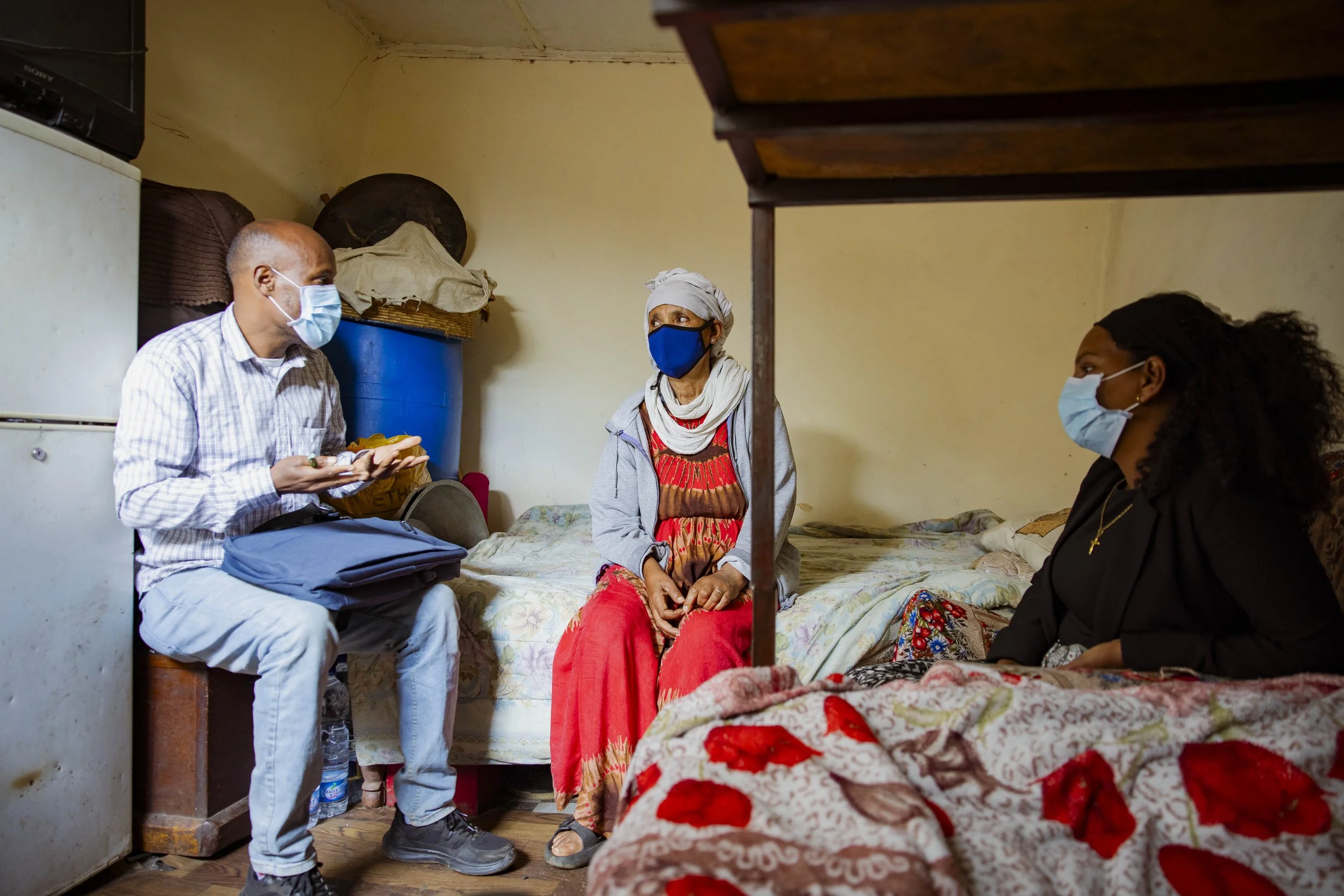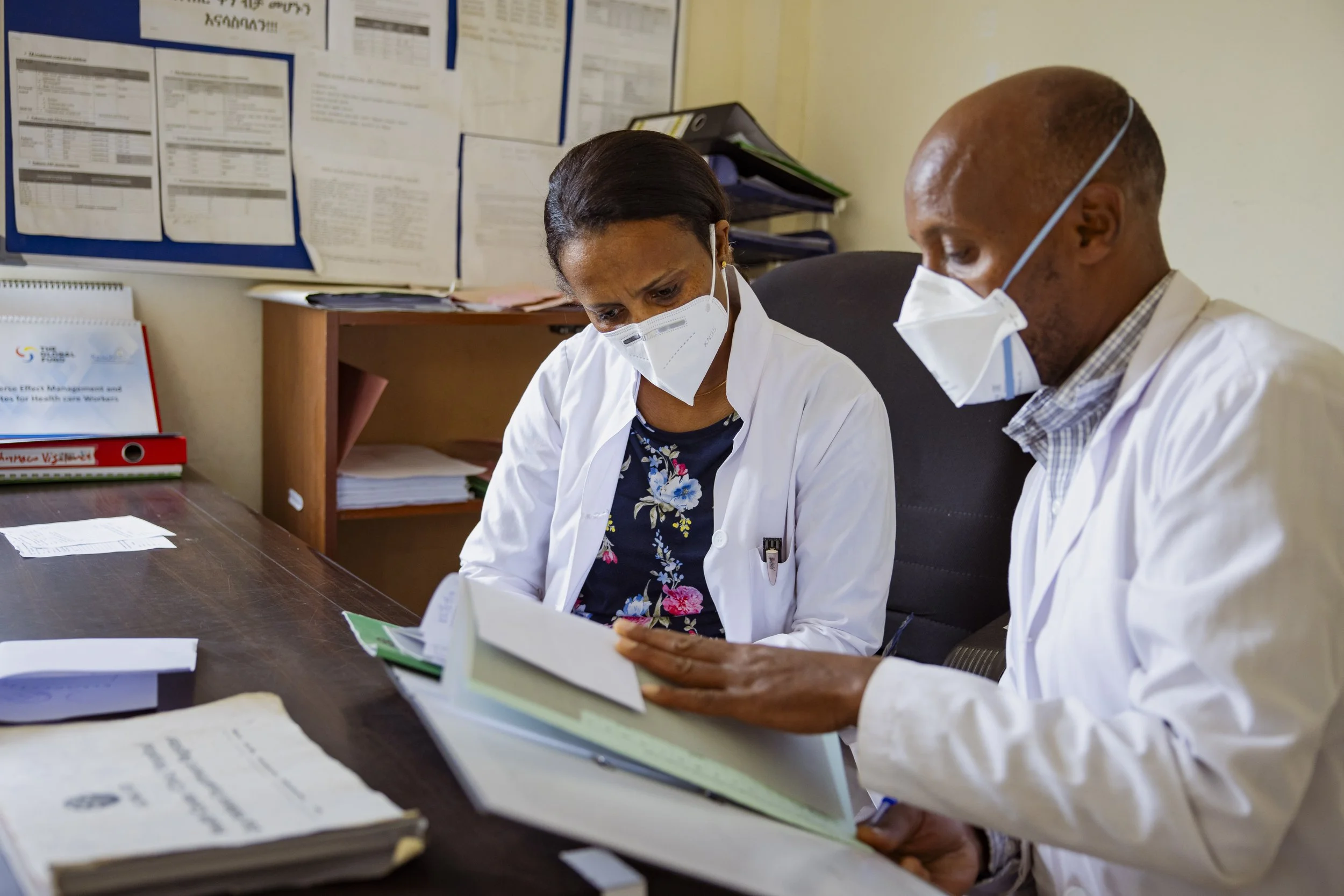Initiation & Scale-up of Drug Resistant-TB Care in Ethiopia
The seven surviving patients of the original eight patients initiated by the GHC/St Peter’s team on DR-TB treatment in Ethiopia in February 2009. Celebrating after their completion of the first 6 months of hospitalization for the intensive phase of their treatment on the isolation ward at St Peter’s Hospital. CHC’s Dr. Sok Thim (middle row second from left in tan jacket), and the Ethiopian National DR-TB manager at the time, Dr. Ridwan Bushra (kneeling in first row on the right) and St Peters DR-TB nurse (in while coat) with patients who reached this critical milestone for themselves and the Ethiopian National Program.
GHC’s Impact on Drug Resistant TB Care in Ethiopia:
In 2008, treatment for drug-resistant TB (DR-TB) was unavailable in Ethiopia—the second most populous country in Africa—despite an estimated 6,000 people suffering from the disease. To help address this emergency, the Global Health Committee partnered with Angelina Jolie and the Jolie-Pitt Foundation (JPF) and worked with the Ethiopian Federal Ministry of Health (FMOH) to initiate and help scale up nationwide DR-TB treatment and care.
As of June 2025, the GHC/Federal Ministry of Health DR-TB program collaboration has treated 2990 men, women and children for drug resistant TB in Ethiopia with outstanding treatment results.
GHC works in 5 DR-TB treatment sites in diverse areas of Ethiopia:
St Peters Hospital in Addis Ababa (since 2009);
Gondar University Hospital in Gondar, Amhara (since 2010);
Yirgalem Hospital in the Sidama region of the Southern Nations, Nationalities, and People’s Region (SNNPR) (since 2012);
Dupti Hospital in Afar Province (since 2023);
Mekele General Hospital in Tigray, providing technical advice and nutritional assistance to DR-TB patients, and survivors of gender-based violence in the hospital’s One Stop Clinic (since 2023)
By 2015, the GHC reported the best clinical outcomes for drug resistant (DR)-TB in sub-Saharan Africa with 78.8% of patients achieving cure and completion of treatment in the British Medical Journal, Thorax. This was achieved despite the severe resource constraints of the program and caring for patients with very advanced DR-TB disease, a high rate of HIV co-infection and severe malnutrition. GHC’s publication raised the bar for other programs in Africa and globally for cure and survival from DR-TB.
Of the 2990 patients treated for DR-TB by the GHC in collaboration with the Ethiopian national program from February 2009-June 2025:
22% were also living with HIV/AIDS.
23% of those treated (703) were children/teens and young adults under age 21
GHC has contributed to the national scale-up of DR-TB care throughout the country through training and shared expertise.
As a core member of the Ethiopian National Technical Working Committee for DR-TB , GHC shared protocols and SOPs for managing drug side effects, supplemental nutrition and social support that were integrated into the national program, and through didactic and hands-on training helped the national in scale-up of DR-TB care. An additional +5800 individuals were initiated by the national program as of June 2024.
Science in service of care: The GHC/St Peters collaborative program on DR-TB significantly contributed to the game-changing international STREAM Trial showing that DR-TB treatment could be shortened from ~2 years and with the use all oral drugs to 9 months. The results from this trial provided the World Health Organization the data for recommending new short course oral treatments for DR-TB.
A New Chance at Life
GIZACHEW
GIZACHEW
33 year old Gizachew, was Global Health Committee (GHC)’s first patient at Gondar University Hospital in northern Ethiopia when GHC expanded drug resistant (DR)-TB care there from Addis Ababa in August 2010 in collaboration with the FMOH. Gizachew had been waiting for 3 years for DR-TB drugs to be available in Ethiopia, and he had been living in a closet (Top left and middle photos) in his family home to protect his wife and children from acquiring DR-TB. He said he had not kissed his children for 3 years. He had high fever and extensive TB with cavitary lesions in both lungs when the GHC team found him (see X-ray in top row, right). In the photo in the bottom row on the left, he is improving on DR-TB drugs under the clinical managment of Dr. Daniel Meressa (GHC Medical Coordinator from 2009-2023) who is standing next to him. After a year and half of DR-TB therapy, Gizachew was cured and was back at work, feeling well, and at his pre-illness weight! (See bottom row, middle, and right photos). Photos and Gizachew’s story is shared with his permission.
MULU
MULU and her family
Mulu and two of her four children are shown in the above photo after 6 months of treatment by the GHC/StPeter’s team for drug resistant TB (DR-TB) on the St Peters DR-TB ward.
Mulu, a 30 year old mother of four, was diagnosed with severe drug resistant TB (DR-TB) pneumonia and malnutrition two months after the birth of her daughter Obse in her arms in the photo above.
Mulu was in respiratory failure on admission requiring oxygen and the DR-TB had spread throughout her body. Baby Obse was found to have acute malnutrition and DR-TB pneumonia. The infant developed septic shock with respiratory failure requiring oxygen and blood transfusions shortly after they arrived at St Peter’s hospital. It was touch and go , but both survived.
The baby’s 3 year old brother Lemi (above on the left) and her 8 year old sister Gadiseh (not shown) were also both coughing and were found to have DR-TB.
Mulu and these 3 children were all successfully treated living together on the ward until they completed their treatments as their village is in a remote region of Oromia. Another sibling, a 10 year old sister was also evaluated and tested negative for DR-TB and was living with her father, who also tested negative, in their home village.
They are all now well, cured of DR-TB, and back at home. The photo and story of Mulu and her children are shared with Mulu’s permission.
How GHC Launched DR-TB Treatment in Ethiopia:
In 2008, it was estimated that 6,000 Ethiopians were sick with drug resistant (DR)-TB also called multidrug resistant (MDR)-TB. However, drugs that were promised to treat DR-TB drugs from the World Health Organization’s ‘Greenlight Committee’ were only approved for 45 people, and these drugs had not arrived. Indeed, they would be delayed for over another year.
We conducted a training of the Ethiopian physicians and nurses on management and care of DR-TB in Addis Ababa in September 2008; and, with the support of Angelina Jolie, brought ten health workers — the core group who would treat DR-TB — to Cambodia for hands-on training in late December 2008/early January 2009. This training and the follow-up south-south training and support of the Cambodian team was a key factor in initiating DR-TB care in Ethiopia and the outstanding survival and cure that was achieved.
The other major critical factor in success of program initiation was flexible funding from the Jolie-Pitt Foundation and then from others and the donation from Eli Lilly & Co of the most expensive drug of the required drug regimen of 5 drugs, capreomycin, which would be used for the first 175 patients on treatment in Ethiopia, while the ‘Greenlight Committee’ drugs continued to be stalled.
For more details on the South-to-South support from Cambodia to Ethiopia and how GHC overcame the challenges associated with initiating DR-TB treatment in Ethiopia, please click here.
First Group of Patients to Receive DR-TB Treatment in Ethiopia
In February 2009, in partnership with the Ethiopian Federal Ministry of Health (FMOH) led by Dr. Tedros Adhanom at the time, the first 8 patients in Ethiopia began their 1.5-2-year regimens for DR-TB in the GHC/St Peters Hospital program.
GHC tried to contact a list of 221 patients who had been diagnosed with DR-TB and were on a list at St Peters waiting for treatment to begin in the country. Tragically, 42 of the 221 had died waiting for treatment, and 100 of the 221 more could not be found and were presumed dead while waiting for treatment. Of the 81 living patients from the list were started on treatment in the first year of the program.
To expand access to care, GHC also reached out to the Missionaries of Charity (MOC) Homeless Shelter to find patients who could not access St Peters on their own.GHC continued to visit the MOC Shelter. The Missionaries of Charity Sisters asked us to see Fetene in their facility, whose story is shared below.
The Ethiopian FMOH had approved GHC to start 5 patients on DR-TB treatment at St Peters Hospital, after further discussion, GHC was granted permission to treat 8 patients who were all severely ill, including Fetene. See his story below.
Key factors in GHC’s initiation and scale-up of DR-TB care in Ethiopia
South-to-south transfer of key knowledge and skills from Cambodia to Ethiopia
Care delivered from the hands of local health workers with local program management
Outpatient care team and home visits
Intensive patient-centered focus on treatment of adverse effects of the treatment
Nutritional supplementation and adherence interventions
Social support including rent when necessary and transportation for clinic visits
Support for lab tests during national stock outs or hospital reagents, for X-rays when hospital facilities were non-functional, for essential imaging studies (CT scans) and urgent procedures such as chest tube placement that affect survival.
Bi-monthly North (Boston)-South (Addis Ababa) clinical conferences to discuss individual cases and programatic challenges led by Dr. Rocio Hurtado.
Clinical training and programatic visits from Boston and Cambodian teams and 3 month Boston physician/nurse team collaborative visit 6 months into the first year of the program at St. Peters
Flexible funding to address the needs.
These factors and others are described in GHC’s publication of its program and 2 year outcomes of the first 612 patients in the program are shared, which raised the bar for other programs treating DR-TB in Africa and globally.
GHC’s partnership with the Ethiopian Federal Ministry of Health overcame significant barriers to care and initiated the DR-TB program in Ethiopia.
GHC has directly initiated 2990 patients on DR-TB treatment as of June 2025 in 4 hospitals while supporting nutrition in a fifth, in different regions of the country. This foundation of DR-TB care and GHC’s role in the Mulit-Drug Resistant TB Technical Working Group and in national trainings have been critical contributions to the scale-up of the FMOH-led National DR-TB Program in Ethiopia, which has reached an additional +5000 patients as of June 2025.
FETENE
The GHC team found Fetene (photo top row, right), in the Missionaries of Charity Homeless Shelter, which houses over 900 homeless men and women in Addis Ababa, where we first met him.
Fetene was in the first group of 8 patients to receive treatment for DR-TB in Ethiopia, which began treatment in February 2009.
At age 19 year he already had gone through several courses of treatment for regular TB as a child and teenager and never recovered missing years of school and education. His family asked him to leave the home because they were afraid he would infect the family. He ended up in Addis Ababa homeless; and, found his way to the Missionaries of Charity Homeless Shelter.
The CHC team diagnosed Fetene with DR-TB with severe infection of both lungs (see x-ray in top left photo) and probable TB of the abdomen (see photos in top row right and in middle row left). Fetene was coughing with fever, had severe malnutrition, a swollen painful abdomen, and chronic diarrhea.
He fought valiantly to improve and after some weeks he was responding to the DR-treatment, feeling better, and gaining some weight. See the photo in lower row on the right, where Fetene is smiling with Dr. Kris Olson; and, see the photo to the right with Fetene feeling well enough to sit-up on the side of his bed.
Unfortunately, a few weeks later, Fetene suddenly went into respiratory failure probably due to a new and deadly gram-negative bacterial pneumonia that attacked his lungs, which were severely damaged and vulnerable. Despite treatment, Fetene tragically died 56 days after he had started treatment for DR-TB.
No doubt, Fetene’s DR-TB would have been curable if he had access to DR-TB care sooner.
Fetene gave permission to use his photos and story with hope that sharing his suffering would help others access care and save lives.
St Peter’s DR-TB Ward and DR-TB Home Visits on March 28, 2025
Dr. Mehret, GHC’s Chief Clinical Coordinator since 2023 arrives at the upper level of the ward to meet with inpatient GHC physician Dr. Bekele (above) and in the GHC office (right).
(Left) Dr. Mehret shares information with Kasim Abato, GHC’s Outpatient coordinator, about some patients who were recently discharged who the team travels to meet in their homes (right) for medical follow-up.
Kassim addresses all the patients concerns and her daughter’s concerns (left) and the patient feels satisfied (right).
Another patient that the outpatient team visits is living with his mother. He is reporting nausea with the medications, so Kassim will prescribe some medication to help him tolerate the DR-TB drugs and check on how he is doing in the next few days.
Meanwhile, Dr. Mehret went to the lower level of the MDR-TB ward at St Peter’s (left) to begin patient rounds with her colleague (middle).
Providing access to DR-TB care in war-affected Tigray and Afar provinces and mitigation of starvation 2023-2025
In 2023, GHC mounted an emergency response to the humanitarian needs in the northern province of Tigray and neighboring Afar following the large-scale two-year civil between Tigray and the Ethiopian government.
GHC re-established the war-disrupted program for MDR-TB in Afar Province and has been supporting the program with technical advice and social and nutritional interventions
In Mekele Hospital in the capital of Tigray Province, GHC provides technical advice and provides daily high-protein hot meals for DR-TB patients who were all found to be malnourished and secured plumpy nut for those who were the most malnourished.
In addition, women who were seeking care in the Mekele Hospital’s ‘One-Stop Clinic’ supported by UN-Ops, for women who had survived rape and abuse during the recent war, were also severely malnourished with borderline BMIs and were supported by GHC with high protein hot meals during their clinic visits.
GHC has provided 22,513 hot meals to severely malnourished MDR-TB patients and One-Stop Clinic patients since July 2023.
*
Isak at 18 months of age is shown in his mother’s arms when he was stabilized and on his way to cure of DR-TB after 6 months of his 18 month treatment for DR-TB at St Peters Hospital in Addis Ababa (upper left photo). Isak and his mother were living in an internally displaced (IDP) camp due to the civil war in Tigray where Isak was exposed to a person who had DR-TB who was in a shared room with the baby and his mother.
When Isak became sick in the IDP camp, he was originally treated for drug sensitive TB with continued deterioration after 3 months of treatment. Extremely sick, he was brought to St Peters Hospital in Addis Ababa in 2022, where GHC found him to have diffuse DR-TB pneumonia and in critical condition. See photo to the right of his CT scan showing diffuse DR-TB pneumonia -- a red asterisk shows a particularly bad region of his DR-TB pneumonia.
Isak required supplemental oxygen, blood transfusions, and intensive blood pressure support, and the team was extremely worried about his prognosis. With these interventions, Isak stabilized and his DR-TB pneumonia been to respond to his new treatment. He was cured by age 3. He has achieved all of his pediatric developmental milestones such as walking, running, talking in complex sentences, and is home with his mother in Tigray. The photos and story of Isak and his mother was shared with permission.
Critical support for the GHC DR-TB program in Ethiopia was received from
Angelina Jolie, Brad Pitt, Nancy & Steven Crown, Wallis Annenberg, Mimi & Bud Frankel, Jeanne Sullivan, Holly Myers & Kirk Neely, and Albro and Cathi Lundy.
Donations of life-saving drugs in the early years that made treating DR-TB in Ethiopia possible were given by Eli Lilly & Co. (capreomycin), the Chao Foundation (cycloserine), Jacobus Pharmaceuticals (PASER), and Janssens (bedaquiline).
Critical foundation and corporate support that sustained this program was received from the
Jolie-Pitt Foundation, Annenberg Foundation, Lilly MDR Partnership, Lilly Foundation, Janssens Global Public Health, Johnson&Johnson Foundation, and the Pittsfield Anti-Tuberculosis Association.
“He who saves a single life is as though he saved the entire world”
ISAK and his MOTHER and the IMPACT of WAR
Patients on their way to cure of Drug-Resistant TB
16 year old student during DR-TB treatment
Vital sign check on the St Peter’s DR-TB ward
young mother to be on treatment for DR-TB
A very malnourished patient with DR-TB on his way to cure at St Peters
20 year old construction worker close to discharge from the St Peter’s inpatient DR-TB ward.
a grandmother, relaxes outside her room on the DR-TB ward at St Peter’s Hospital during treatment for DR-TB
Dr. Rocio examines Sultan who had extensively drug resistant TB and very severe disease on the St Peter’s DR-TB ward.
Dr. Mehret Befekadu, GHC’s Chief Clinical Coordinator, takes Dr. Atul Gawande, former Assistant Administrator for Global Health of USAID on rounds at St Peters DR-TB Ward in 2024 (Above). Dr. Befkadu with 3 year old patient Lemi who was receiving therapy for drug resistant TB (right).
Dr. Daniel Meressa (in the middle), GHC Medical Coordinator from 2009-2023 on rounds with Dr. Bekele (left front) attending a 19 year old being treated for drug resistant TB (DR-TB) with the complication of an enlarged heart due to his severely TB-damaged lungs at the St. Peter’s Hospital DR-TB ward in Addis Ababa, Ethiopia. Dr. Daniel is speaking to the patient’s sister in this photo. In the first years of the program 5% of our patients had the same problem of an enlarged heart that occurred because of their severely damaged lungs by recurrent TB, which made it difficult for their hearts to pump blood through them, resulting in heart damage that was not reversible, even when they were cured of drug resistant TB
Dr. Yohannes was caring for DR-TB patients at the Gondar University Hospital DR-TB ward in this photo with Dr. Anne. Yohannes was infected with DR-TB as a medical student and was in the first group of patients who received DR-TB treatment in the the GHC/MOH collaborative program in Ethiopia. See photo at the very top of this page where he is holding Dr. Thim’s hands in the middle of the first group of 7 DR-TB patients who made it through the first phase of treatment in June 2009.
Patients on the DR-TB Ward at St. Peter’s Hospital in Addis Ababa enjoying a music concert and fresh air.
Healing the world one patient at a time
Dr. Rocio and Dr. Bekele examine Sultan’s chest tube and breath sounds at St Peter’s DR-TB Ward.














